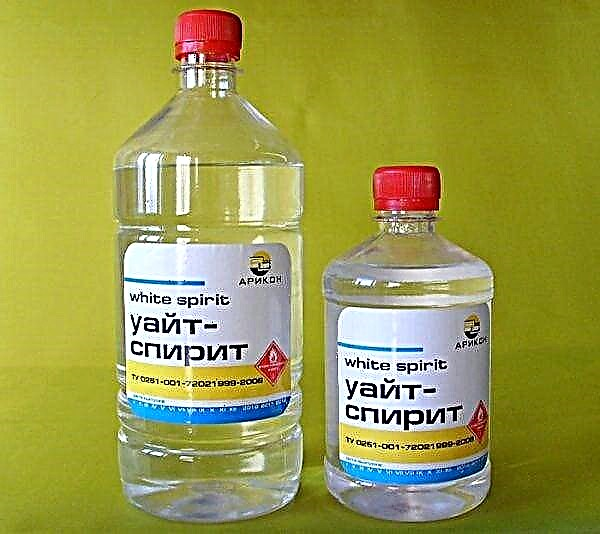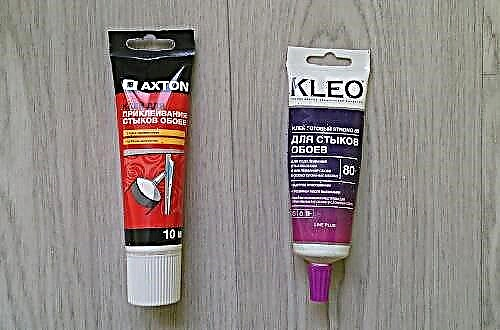The basis of oil paint is pigment mixed with varnish to a homogeneous state. While the mixture is not used, heavy powder pigment can settle, the middle freezes, and oil accumulates on top, so you need to thoroughly stir or shake the jar before work. If you need to bring the substance for staining to a more liquid state, first answer two questions:
- What are you going to use diluted paint for: as a surface paint or as a primer?
- What kind of drying oil is involved in the composition?
It is important for us to decide on these points, since oil paint should be diluted with a substance similar to that in the composition.
If the can with the paintwork material stood for a short time after opening, then the thickening is eliminated by adding drying oil. However, this substance differs by the manufacturing method, so if you make the wrong choice, you risk spoiling all the coloring material. When it is necessary to reanimate a highly compacted paint, then do not do without a solvent. We add it if we prepare the primer.
Types of drying oil in oil paints
One type of paint can be used for surface treatment in the room, the other - strictly for external work, because it has toxic emissions (pungent odor).
The method of application depends on the type of drying oil:
- The first is natural drying oil, made from hemp, linseed, and soybean oil. It is marked MA-021, and it is suitable for coloring windows, doors and other elements of the premises. The exception is the floor and ceiling, because the oil base does not allow moisture to pass through, thereby correct air exchange in the room may be disturbed.
- The second type is a composite drying oil, created by mixing solvent and oil. This drying oil is diluted with turpentine, white spirit, gasoline, solvent, it is characterized by the presence of a strong odor, and evaporation is harmful to the body. Although with a similar composition, the paint costs less, but doing home repair with it is contraindicated. It is designated by a marker MA-025.
After reading the label and composition, choose either linseed oil based linseed oil, or buy a suitable solvent.
The process of dilution with drying oil
Diluting the paint is not difficult, but it is worthwhile to step by step and economically pour any diluting substance, because if it is oversaturated with drying oil, it takes longer to dry the surface.
- for the convenience of mixing and eliminating clots, we transfer the paint and varnish substance into a suitable container,
- pour in oil in small portions and begin to mix thoroughly, monitoring the density,
- repeat the procedure for adding oil and bring the mixture to a suitable consistency for us,
- wait ten minutes, after which we filter the composition through a sieve to eliminate lumps.
 If you add too much drying oil, the paint will dry much longer to the content ↑
If you add too much drying oil, the paint will dry much longer to the content ↑Solvent selection and use
Before choosing a solvent, consider that some substances can change the properties of the paint. Basically, they use either multicomponent prepared mixtures under numbers (for example, “Solvent 647”), which contain alcohols, ketones, esters, or organic substances with a high degree of volatility in various proportions (white spirit, turpentine, kerosene, gasoline, etc.). d.).
Add the solvent carefully and little by little so as not to spoil the composition, since excess can cause the destruction of the bonds between the pigment and drying oil.
Types of Organic Solvents:
- White spirit is the most used tool that allows you to clean brushes and degrease surfaces, as well as dilute oil paints, varnish, varnishes. It should be borne in mind that ordinary white spirit has a low ability to liquefy, so you need to buy refined,
- Turpentine, obtained from various wood processing materials, is one of the most popular substances in order to bring dried paint and varnish materials back to life. A mixture is prepared on the basis of turpentine and white spirit, taking each substance in a ratio of one to one. Or use purified turpentine, which helps speed up the drying process. If you take unrefined, then time, on the contrary, increases,
- Kerosene can also be used to dilute dried paint. But before that, it is mixed with turpentine or with desiccants. Kerosene is not very popular because it lengthens the drying time of the painted surface,
- Gasoline can be used as a diluent to reduce the viscosity of the ink. It also gives the mixture a haze.
 Refined white spirit has a better liquefaction ability than normal
Refined white spirit has a better liquefaction ability than normalBefore choosing a method of rehabilitation of oil paint, you need to decide what to purchase - a solvent or thinner? You will need a solvent for long-standing and hardened paints. When adding it, you need to wait a few minutes or hours until the consistency becomes suitable for work. If the mass became thick, then a ready-made thinner or drying oil will help you. It reduces the viscosity of the composition.
Drying oil
Since most oil paints are made on their basis, it is quite possible to use drying oils for dilution. Dense mixtures are also recommended to be diluted with them. Drying oil is added to the compositions designed for finishing wooden surfaces - a thick layer applied to an unpainted tree will crack and crumble over time.
Before you start breeding, you must study the instructions on the label. To obtain an ideal result, it is necessary to use the type of drying oil that was used for its production:
- natural: based on linseed or hemp oil with the addition of metal compounds (desiccants), which act as accelerators, this diluent for oil paints is odorless, therefore it can be used even in residential premises,
- oxol: in addition to the above, in its production it is allowed to use other types of vegetable oils, partially (up to 40%) they are replaced with synthetic oil-polymer resins,
- combined: obtained by adding to the oxide up to 30% white spirit,
- alkyd: based on alkyd resins mixed with modified oils, desiccants and solvent (white spirit),
- compositional: it belongs to the most budgetary compositions, it is made on the basis of synthetic substitutes (oil processing products) of vegetable oils, it is possible to distinguish such drying oil by its reddish tint, it has a pungent odor, some of its types dry very much, plus they quickly crumble after hardening.

To the question, which thinner for oil paints is better, you can answer - natural. But when choosing, pay attention to color. Dark shade and opacity indicate that this is a fake.
Turpentine
This diluent is made from resin of coniferous trees by distillation. The industry produces turpentine of the following types:
- gum: the most valuable, steam distillation,
- wood, obtained by dry distillation, a similar method is possible only when using a tree containing an increased amount of resins,
- extraction: product of volatile fractions evaporated using organic solvents,
- sulphate: in fact, it is a waste obtained in the manufacture of paper and paperboard, digested in a solution of caustic and sulphurous sodium, the main reagent is sodium sulphate, because of its high toxicity it is not recommended for use in residential premises.

Gum and wood turpentine dissolves perfectly, does not add excessive haze to the composition, has a pleasant coniferous smell. It is also used as a solvent for oil-phthalic paints. Such compounds are absolutely non-toxic and can be used in residential premises.
White Spirit
We will tell you what else you can dilute oil paint if it is thickened. White Spirit. A similar product made by distillation of oil perfectly dissolves oils and fats. Outwardly, it looks like a clear, slightly oily liquid.
But you can work with it only in ventilated areas. His poisonous fumes are dangerous. Contact with white spirit is also undesirable. Therefore, when using it, do not forget to wear gloves.
Solvent
Another oil product that differs from mineral spirits only in hydrocarbon composition. Since the solvent is obtained by evaporation of the oil at a lower temperature, it is lighter and evaporates faster.
If white spirit makes the paint dull, then the solvent is devoid of this drawback. After all, there are almost no oil deposits in it.
Solvent 647
Dilute oil paints with caution. After all, this type of diluent, in addition to alcohols, hydrocarbons and ethers, contains acetone. If you add it to the paint a little more, the quality of the composition will immediately decrease. The film may become white or dull.
As solvent 467 belongs to aggressive substances, it is better to use it to remove old coatings and film formers. But here nitro enamels and nitro-varnishes can be diluted without fear. Rinse well with 647 solvent and brushes.
Is it possible to dilute the paint with gasoline or kerosene
Quite. Moreover, paints that are highly thickened during storage are best dissolved in kerosene. Kerosene should be selected well cleaned, otherwise the paint will lose its glossy sheen. Gasoline is better to take brands A-80. When added, the properties of the composition do not deteriorate. The bank should indicate that it can be diluted with white spirit. 
Due to the specific smell, it is not worth using gasoline and kerosene indoors. After all, it erodes slowly. Plus, the drying speed when adding gasoline or kerosene will slow down.
Cultivation of artistic colors
Such formulations are ground pigments dissolved in bleached linseed oil. We will tell you how to breed such oil paints. Solvents should be selected for them very carefully. For these purposes, you can use:
- refined vegetable oils: hemp, linseed or sunflower oil,
- pinen: one of the components of the resin of coniferous trees, goes on sale under the name “Thinner No. 4”, how to use a similar thinner for oil paints can be found on the label,
- multicomponent compositions with the addition of pinene, varnish and oils.
Thus, when choosing diluents for oil compositions, you should focus on the type of surface and the requirements for it. But it should be remembered that excesses of even the highest quality solvent may not have the best effect on the quality of the coating.
How to dilute oil paint?
When choosing a solvent, pay attention to what the paint is intended for. The fact is that this type of material includes two large groups that are divided by area of application:
1. Solutions used for painting surfaces of residential or utility rooms. For these purposes, traditional compounds are suitable, which are presented in abundance on the shelves of construction stores. Although the demand for these products has recently declined, in certain situations it is the oil solution that can be the optimal solution.
It is necessary to dilute such a mixture in the following cases:
- The material is too thick.
- It is necessary to lay the base layer.
- Painting is done on wood. A not too thick composition fits well on such a basis, otherwise it will not work to achieve a strong grip.
 To properly apply oil paint with a spray gun, it must first be diluted
To properly apply oil paint with a spray gun, it must first be diluted In addition, it often happens that after use there remains a part of the paint, which even dries in a short period of time. This will require dilution.
2. Artistic oil paints. They are great for amateur or professional drawing, as well as painting interior compositions. It is necessary to dilute such compositions with greater caution, therefore, special diluents are selected for them.
 Professional thinners for art oil paint
Professional thinners for art oil paint
Gasoline and kerosene
These options are recommended to be used in the absence of other mixtures and only for outdoor use. A significant disadvantage of solutions is the specific smell, which can cause dizziness and poisoning. This is due to rapid evaporation. But it is kerosene that is the best solution when you need to dilute the old composition, which has had time to thicken greatly.
 When paint is diluted with gasoline, the painted surface becomes dull.
When paint is diluted with gasoline, the painted surface becomes dull.
Drying oil
This is a universal solution, besides drying oil is part of oil paints. But it must be borne in mind that the diluent must correspond to the kind of substance that is included in the coloring material.
To obtain the necessary information, you need to pay attention to the marking of paint mixes. The following notation is distinguished:
- PV-024. Such products are made on the basis of pentaphthalic drying oil.
- MA-021. The composition includes natural drying oil, which contains more than 95% vegetable oils.
- GF-023. It is made with the addition of glyphthal drying oil. It is an alternative to natural.
The correct definition of the components helps to obtain the desired result.
 Drying oil “Oksol” consists of natural oils for 55%, 5% of desiccant, the rest is white spirit, in its properties “Oksol” practically does not differ from natural drying oil, but its cost is much lower
Drying oil “Oksol” consists of natural oils for 55%, 5% of desiccant, the rest is white spirit, in its properties “Oksol” practically does not differ from natural drying oil, but its cost is much lower
Dilution Order
No less important is the process of diluting the paint with your own hands, because its exact implementation is the guarantee of the absence of further problems.
Events are held in the following order:
- A container with paint is opened, the thickness is evaluated and thorough mixing is performed. To do this, use an improvised tool or a prepared clean stick.
- The necessary proportion is determined. For each solvent, the indicator may be different. The exact amount of substance depends on the thickness of the paint, but should not exceed 5% of the total mass. Although, if necessary, get a mixture for the base layer or primer of the walls, the volume of white spirit and drying oil can reach up to 10%. To dilute the mixture in the best way, diluent is added directly to the jar. It should be infused gradually in small portions. This will restore the composition and mix it well.
- Next, the paint is poured into containers for work. During the coloring process, the material may thicken, so you need to periodically mix the solvent.
To breed paint that has stood open for some time is more difficult. Work order:
- The film that has formed on the surface due to exposure to oxygen is carefully removed. It is impossible to leave or mix it, then it will be impossible to completely get rid of hard lumps.
- A small amount of kerosene mixed with white spirit is poured into the container, everything is well mixed. If required, then thinner is added.
- Then you can stain this mixture or wait until the kerosene has evaporated, and use only one component for dilution.
Important! The work is carried out with the observance of increased precautions, since oil paint and all substances used for dilution are flammable and toxic.
How to dilute oil paint for application with different tools
The use of different tools for painting walls, ceilings or other substrates involves diluting the composition to the desired level of viscosity. At home, this parameter is determined using a simple device - a viscometer, which can be purchased at the store.
The device is a funnel with a nozzle, which can be of different sizes. Based on the period of time the poured composition flows through the hole, the viscosity level in seconds is determined.
 Steel viscometer
Steel viscometer
The process looks like this:
- After adding solvent to the container with paint and mixing, a viscometer is immersed in it.
- A stopwatch is prepared in advance. You can use any other device.
- The device is taken out of the structure, at the same time the timer starts.
- After the mixture completely releases the glass (funnel) of the device, the stopwatch turns off. The value is fixed.
To paint the surface with brushes and a roller, the viscosity should be at the level of 10-15 seconds, and for the spray gun - 25-30 seconds depending on the model.
Dilute oil paint
 Probably, everyone can recall a similar case that during the repair period more than once by their own carelessness they forgot to close the can of paint, from which, to the great disappointment, the material froze and was no longer suitable for use. The following are examples of possible solvents for paints that will help you save thickened paint, or simply dilute a new one.
Probably, everyone can recall a similar case that during the repair period more than once by their own carelessness they forgot to close the can of paint, from which, to the great disappointment, the material froze and was no longer suitable for use. The following are examples of possible solvents for paints that will help you save thickened paint, or simply dilute a new one.
Oil paints, by themselves, can be either thick-wiped, or immediately have the consistency necessary for their use. Paints, conventionally called "thick", in this form are used extremely rarely, most often they are diluted with a solvent. Also, dried paints or those that are planned to be used as a primer are bred with this specific liquid.
The type of solvent for the paint is determined according to the properties of the material on which the paint will be applied.
Oil paint is easily diluted with many chemicals, which are extremely easy to purchase in hardware stores. Examples of such solvents include turpentine (whether or not refined), gasoline, 647 kerosene solvent (only with desiccant added), white alcohol. However, white alcohol, solvent 647 and turpentine are by far the most widely used types of solvents.
Do I need to dilute oil paints
It is quite possible to use oil paints for painting without thinners. If the texture is soft enough and you like relief works, then boldly draw them in their pure form. However, the paint may be too dense and thicken over time. In this case, you will certainly be faced with the question of how to dilute oil paints. The main thing here is to understand that any solvent makes the work less bright. And if you use natural oils, then keep in mind that the drying time of the finished painting will increase significantly. In any case, such products should be kept in their arsenal in order to be able to wash their brushes and palette.
Ready thinner
In art stores you can find thinners of oil paints, which differ in numbers. They include turpentine, pinene and white spirit. The number means the ratio of these substances. Thinners are used not only for drawing, but also for washing brushes and cleaning the palette.

Oil as a diluent
The first thing that comes to mind when asked about how to dilute oil paints is, of course, vegetable oils. Most often used linseed or hemp. But it is best to carefully read the composition of the paint and choose a similar oil in an art store. Such an additive will make the material softer and more pliable. In addition, the work will have a characteristic brilliance. After drying, the picture is covered with an invisible elastic film, which will protect it from the destructive effects of external factors. If we talk about the shortcomings of such a diluent, it is worth noting an unpleasant suffocating smell.

Terpentine and White Spirit
Purified turpentine is a good option for large-scale paintings. Oil paints for drawing become viscous enough and do not dry for a long time, and therefore you will always have the opportunity to make adjustments to the work. However, in no case do not use household terpentine, only from an art store. This substance can make the paint yellow.
As for mineral white spirit, it dries much faster than the previous substance. In addition, it is less picky in storage and safer in terms of chemical composition. And the price of such a diluent is lower. However, if the substance is of poor quality, a white coating may appear on the finished work after drying.
Art varnish
If you do not know how to dilute oil paints, then try painting varnishes. But in no case do not confuse them with coverslips, which are applied about a year after painting. The varnish should contain wood resin and solvent.
Oil paints for painting, diluted in this way, become more malleable and at the same time more dense, which provides a good overlap. In addition, the finished picture becomes bright and shiny, which is difficult to achieve using only oil or thinner. After drying, the paint becomes more durable and resistant to external influences.
To make the structure of oil paint more soft, often use the so-called double. It consists of one part of varnish and two parts of linseed or hemp oil.

Tee Recipe
Experienced artists prefer to independently prepare a thinner for oil paints, taking into account their needs. The most common “tee” recipe includes the following components:
- pictorial varnish (it is better to choose dammar or mastic),
- hemp, linseed or poppy seed oil (the latter is considered one of the most transparent and purest),
- turpentine or a solvent for art oil paints (most often use white spirit).
All components are mixed in a clean glass container in equal proportions. The vessel must be tightly closed, otherwise the solvent will begin to evaporate and lose its properties.
Helpful information
Beginners and experienced artists will certainly appreciate the following tips.
Never use solvents from construction stores, because they not only have an unpleasant odor, but also give the colors a shade of yellowness after drying.
Some thinners make the color of the paint pale, but as they evaporate, the shade may become brighter again.
Before using this or that solvent in work on a picture, experiment on a trial piece of canvas.
Do not use too much thinner, because oil paint can become loose and will stay worse on the surface.
For quick drying, use turpentine or art varnish, and if you have a long work to do, it is better to give preference to vegetable oil.
When working with solvents (especially chemical ones), wear gloves and gauze dressings, and do not forget to ventilate the room.
Always dilute a small amount of paint, because in this form it is not subject to storage.
If you want to give your picture a pleasant aroma, then use cedar or fir varnish as a solvent.

Can diluent be reused?
Quite often, artists dip brushes stained in paint into a container with a solvent. As a result, it becomes cloudy and, at first glance, completely unusable. A dirty diluent may well be reused if a filtration procedure is carried out. To begin, let the liquid stand to precipitate, then pass it through a paper filter. The procedure must be repeated until the precipitate ceases to precipitate. Pour the filtered thinner into a clean glass container and tighten the cap tightly.
The right diluent for oil paints will make your work brighter and speed up the drying process.



